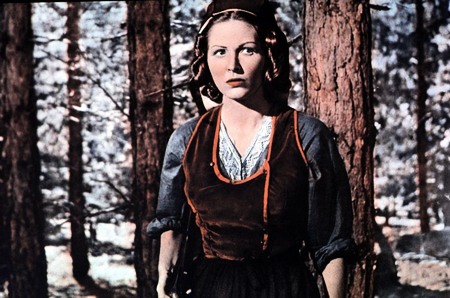Here’s an interview with Sergio Grieco translated from an old copy of Unita. I don’t believe there’s any other interview with Grieco anywhere. I’d love to be proved wrong because he was a decent director who has been rather forgotten and was never really appreciated as much as he deserved. Note, La vita riprendera was eventually released as Il sentiero dell’odio in 1950.
Certain regions of Italy have a destiny, that we’ll never know whether to define them as gloomy or incomprehensible; those forgotten places. Sometimes the work of a person of genius, a person of culture, a storyteller, is able to express to break through these provincial barriers, reaching a national and even international notoriety. So we can talk of Verga’s Sicily, of Grazia Deledda’s Sardinia and of Sveno’s Trieste. But apart from that it’s a careful voyager who tries to open their eyes to the reality of these places and describe it, as we have said about Lawrence and Sardinia, or of Stendahl and an unknown Parma, traced even up to the pedantic notations of a Montaigne.
But today we are seeing these forgotten regions of Italy come to light for their strengths, for their life, for the problems they face. It’s the limited case with Calabria, which is still dominated by the same culture that has existed for centuries and which has become tragically bought to the attention of the world thanks to the bloody reality of recent years, because of the poignancy of its social conflict. We speak of Calabria in the papers and the magazines thanks to it’s corruption and bad governance; it has also been reignited by the re-edition of one of its stories, Il mirasi, and also – although it’s not much talked about – it’s representation today in the cinema. Certainly, the Calabria which has become the focus of the cinema isn’t the Calabria that has seen the journalistic or parliamentary investigations, nor is it the Calabria of discussions about the law in the Sila.
Cinema is reflexively attracted to the beauty of a land, to the quality of its people, by stories rich in ideas. So two films that are currently being shot in Calabria have what could be called a historical setting. They are both costume dramas and are set some fifty years ago. The first is Il brigante Musolino with Amedeo Nazzari and Silvana Mangano. The second is La vita riprendera by Sergio Grieco. Grieco’s crew have now left Calabria after having shot a good part of the film there. We found them encamped inside and outside a huge shed in a studio in Palatino, where they were shooting some scenes. The architect Egidi had reconstructed in this studio the facade of a Calabresian house, authentic enough for them to shoot the remaining scenes of the film.

During a break between shooting one scene and another, we talk to Sergio Grieco, the young director. As such it’s his debut, his first full length film. But Grieco certainly isn’t new to cinema, which he has been fascinated with for years. His direct contact with a movie camera goes way back to 1932, a time when, in Moscow, he was assistant to the director Nicola Ekk for his film Verso la vita, which was shown at the first Venice festival. More recently, having collaborated with De Santis on Caccia tragica, he worked alongside the French director Rene Clement on La mura di Malapaga.
Now Grieco is telling us about his new film. He has a definition to give us, that it’s an Italian western. And in fact this Italian film has many echoes of the westerns which are such a major part of cinema across the ocean. Firstly in its creation and description of a landscape, that of the Sila. Both the interiors and exteriors were shot in the area around the village of Silvana Mansio, at some 1400 metres height, as well as near to Camigliatello, San Giovanni in Fiore, Savelli and Campana.
“If I’d been able to,” says Grieco, “I would have shot it in the hills hundreds and hundreds of metres higher. Not only for the landscape, which is multiform and fascinating, but also because of the other things we saw, the traditional feasts, for example, which are so rich in emotion that they’d affect any director.” Another point of contact with the American western is the story, which is about Mascaro and the barons of Pietramala. Grieco and his scriptwriters Majorana, Pescatore and Veo based the story on old reports from newspapers from forty years ago. La vita riprendera in fact begins in 1910.
Grieco is keen to return to his work. The actors are being prepared for a new shot. They’re all young actors, as is suitable for their roles, but already known to the public. There’s Carla del Poggio, Marina Berti, Andrea Cecchi, Vittorio Duse, Ermanno Randi and Piero Lulli. It’s a happy crew, which supports each other with enthusiasm through the difficulties of the long stay in Calabria and with which the director Grieco is more than satisfied. And, as is apparent, the actors and the rest of the crew are more than happy with the director, quote to the contrary of the cliche of the distant, incomprehensible director.
Grieco isn’t the only one making his debut in this film. He’s entrusted the score to Mario Zanfred, who is working in film for the first time. Zanfred has just started work on the score, which is pleasing him hugely. He previously had great success at the Music Festival in Venice with his Quarta sinfonia in onore della resistenza. “But I,” Grieco smilingly tells us, “entrusted him with doing the music for my film before his success in Venice.”